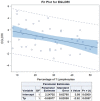Impact of T Lymphocytes Isolated from Liver Perfusate of Deceased Brain Donors on Kidney Transplantation: Preliminary Evidence and Future Directions
- PMID: 37510901
- PMCID: PMC10381596
- DOI: 10.3390/jcm12144786
Impact of T Lymphocytes Isolated from Liver Perfusate of Deceased Brain Donors on Kidney Transplantation: Preliminary Evidence and Future Directions
Abstract
Background: Ischemia/reperfusion injury (IRI), acute rejection (AR), and delayed graft function (DGF) might occur as major complications following kidney transplantation. Thus, the identification of biomarkers for the IRI, AR, and/or DGF development becomes crucial as it may help to guide post-transplant management. Natural killer (NK) cells, hepatic interstitial T-lymphocytes (T-Li), and NK-T cells are crucial in both innate and adaptive immunity after abdominal solid organ transplantation. Hence, the aim of this study was to evaluate the impact of the immune system after graft reperfusion during KT in adults in order to identify predictive biomarkers.
Methods: The NK, T-Li, and NK-T phenotypes and concentrations were retrospectively analyzed in a consecutive series of liver perfusates obtained after organ procurement flushing the abdominal cavity recovered from deceased brain donors (DBDs). Their percentage was compared with the renal transplant recipients' characteristics with kidneys taken from the same DCDs. The hepatic perfusate cells were purified by density gradient centrifugation. Flow cytometric investigation was used to determine their phenotype with the following immunological markers in order to determine the relative percentage of T-Li, NK-T, and NK cells: CD3, CD4, CD8, and CD56.
Results: 42 DBDs' liver perfusates were analyzed. The related clinical outcomes of kidney transplant recipients from 2010 to 2020 performed at our Institute were evaluated. Time in days of delayed functional recovery of transplanted kidneys (DGF) (p = 0.02) and the onset of secondary infection from a cytomegalovirus (p = 0.03) were significantly associated with the T-Li percentage. An increased relative risk (HR) of organ survival was significantly associated with the percent cell concentration of T-Li and time to DGF, on COX analysis, were (HR = 1.038, p = 0.04; and HR = 1.029, p = 0.01, respectively). None relevant clinical outcomes in kidney transplant patients were associated with the specificity of the NK and NK-T cell proportions.
Conclusions: A new potential role of T-Li cells was detected in the context of hepatic perfusate from DBDs. It could detect potential impacts in organ allocation, surgical procuring techniques, and in the analysis of IRI pathophysiological events.
Keywords: T lymphocytes; deceased brain donors; hepatic perfusate; kidney transplantation.
Conflict of interest statement
The authors declare no competing interest. This research did not receive any specific grant from funding agencies in the public, commercial, or not-for-profit sectors.
Figures


References
-
- de Leur K., Dieterich M., Hesselink D.A., Corneth O.B.J., Dor F.J.M.F., de Graav G.N., Peeters A.M.A., Mulder A., Kimenai H.J.A.N., Claas F.H.J., et al. Characterization of donor and recipient CD8+ tissue-resident memory T cells in transplant nephrectomies. Sci. Rep. 2019;9:5984. doi: 10.1038/s41598-019-42401-9. - DOI - PMC - PubMed
-
- Jahn N., Sack U., Stehr S., Vöelker M.T., Laudi S., Seehofer D., Atay S., Zgoura P., Viebahn R., Boldt A., et al. The Role of Innate Immune Cells in the Prediction of Early Renal Allograft Injury Following Kidney Transplantation. J. Clin. Med. 2022;11:6148. doi: 10.3390/jcm11206148. - DOI - PMC - PubMed
LinkOut - more resources
Full Text Sources
Research Materials

